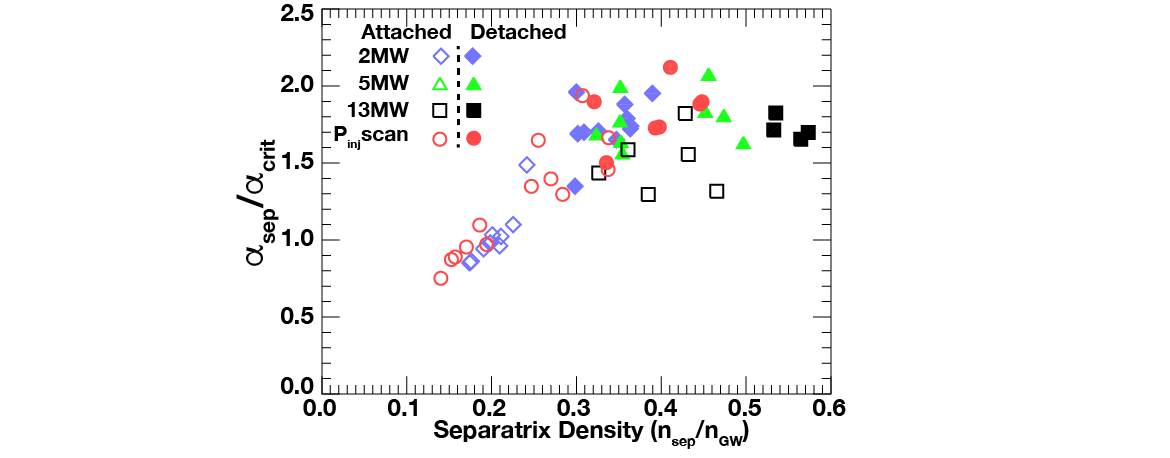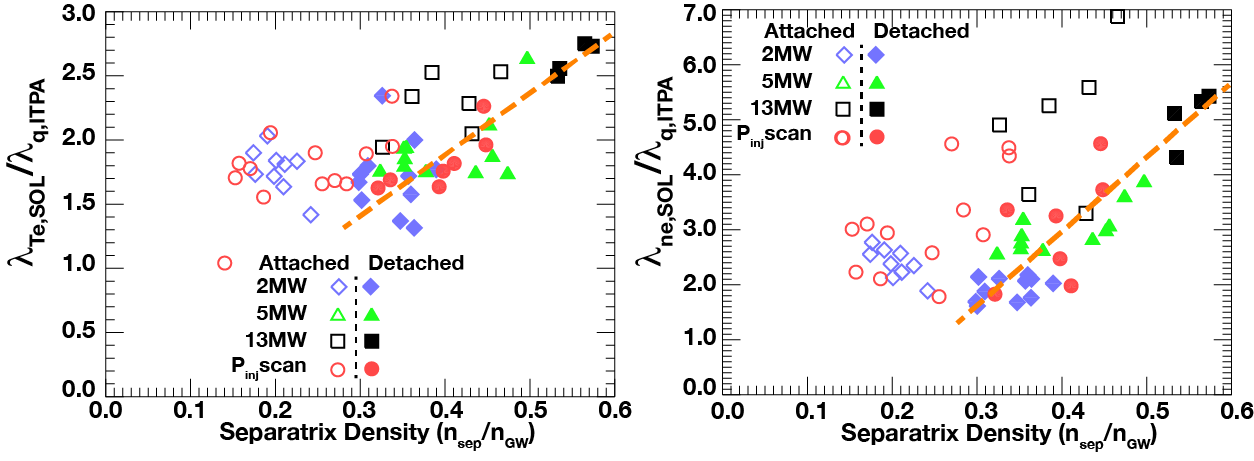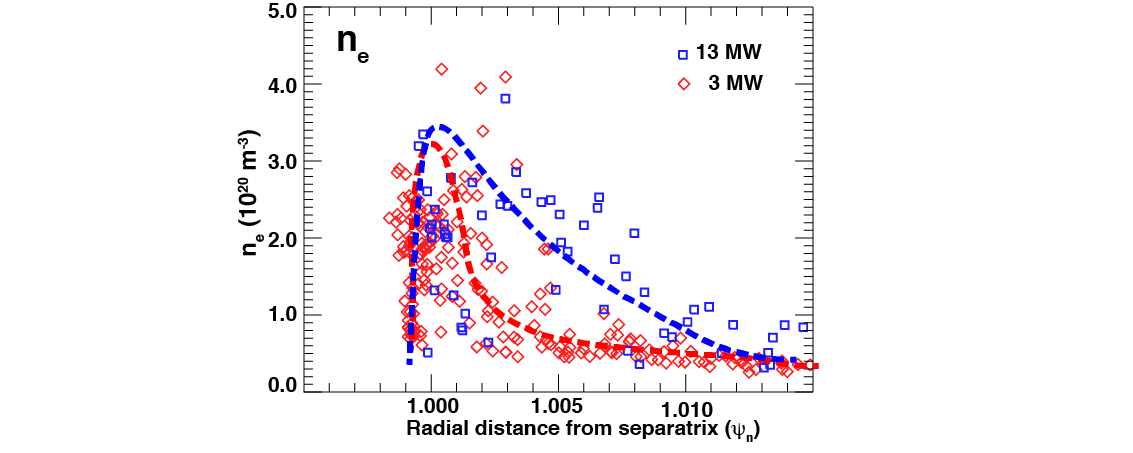Speaker
Description
The radial width of heat flux flowing into the DIII-D divertor is found to expand beyond that of the established empirical scaling (1) for conditions of high input power and high plasma density. This expansion is consistent with a scrape-off-layer (SOL) radial pressure gradient limited by the MHD ballooning stability limit, but does not inherently result in a degradation of edge pedestal pressure or core confinement due to additional edge turbulence. This result has favorable implications for access to dissipative divertor regimes in future reactor-scale tokamaks.
At low heating power, ~3 MW, the DIII-D SOL heat flux width remains consistent with the empirical scaling law (1), dependent only on the midplane poloidal field. The low power midplane separatrix normalized pressure gradient, $\alpha _{MHD}$, increases with the higher density required for divertor detachment. At high heating power, ~ 13 MW, a higher separatrix density, $n_{e,sep}$, and resulting higher separatrix pressure, are required to achieve divertor detachment. For $n_{e,sep}$ approaching half of the Greenwald density limit, $n_{GW}$, the separatrix pressure gradient saturates, consistent with previous studies (2). Further increases in density or input power result in a broadening of the SOL and divertor temperature and density profiles, maintaining the pressure gradient near the MHD limit. The increase and saturation of the separatrix pressure gradient is summarized in Fig. 1, where the pressure gradient is normalized to the MHD ideal ballooning limit, $\alpha _{crit}$.  The saturation in $\alpha _{MHD}$ occurs at the same separatrix density even for attached divertor conditions at high power indicating the saturation is not due to divertor detachment.
The saturation in $\alpha _{MHD}$ occurs at the same separatrix density even for attached divertor conditions at high power indicating the saturation is not due to divertor detachment.
The separate components of the midplane pressure profile are measured with Thomson scattering for the electron pressure and Charge-Exchange Recombination spectroscopy (CER) of the CVI impurity emission for the ion temperature and density contributions to the pressure profile. The separatrix normalized pressure stability limit, $\alpha _{crit}$, is evaluated with the ideal MHD code BALOO based upon magnetic equilibria across the data set at $\alpha _{MHD}\approx2.2-2.7$. As shown in Fig. 1, the measured pressure gradient, $\alpha _{MHD}$, saturates at about 50% above the MHD limit. The high pressure gradient is likely due to the high $T_{i}>>T_{e}$, at the separatrix taken from CVI CER measurements. Recent measurements from main ion CER indicate a separatrix $T_{i}$ much closer to $T_{e}$, resulting in a pressure gradient closer to the stability limit.
The saturation of the SOL pressure gradient results in an expansion of the SOL width as power and density are increased, as shown in Fig. 2. The SOL $T_{e}$ width, remains constant at ~1.8 times the ITPA $\lambda_{q}$ scaling for $n_{sep}∕n_{GwW}\leq0.3$, but then increases for higher density. The SOL $\lambda _{Te} $ is ~40% below that implied by the ITPA scaling given that $\lambda_{Te}\sim\frac{7}{2} \lambda_{q}$ at these collisionalities. For detached plasmas, shown by solid symbols in Fig. 2, as the input power is increased from 2 MW to 13 MW while the density required for detachment increases, the SOL $\lambda_{Te}$ and implied $λ_{q}$, increase $\geq$ 50%. Expansion of the SOL density width, $\lambda_{ne}$, is even stronger with a factor of 2.5 increase in width for the high-power case with divertor detachment. Implications for the SOL expansion at high power and density can be seen in the divertor plasma as well.  Shown in Fig. 3 are radial profiles at low and high power through the divertor leg halfway between the target and the X-point. These are both detached plasmas with near complete exhaust power dissipation. At high power the divertor plasma is ~3 times broader than the lower power case with both at $T_{e} \sim5-10\,eV$ at the same vertical location. The broader profile allows for greater total radiated power without a significant increase in the divertor density.
Shown in Fig. 3 are radial profiles at low and high power through the divertor leg halfway between the target and the X-point. These are both detached plasmas with near complete exhaust power dissipation. At high power the divertor plasma is ~3 times broader than the lower power case with both at $T_{e} \sim5-10\,eV$ at the same vertical location. The broader profile allows for greater total radiated power without a significant increase in the divertor density.
The increased turbulence and radial transport at high power and density might be expected to degrade the edge pedestal and resulting core confinement. However, no degradation of the pedestal is found with increased SOL width at high power and detachment onset. For low and high-power the density is increased with deuterium injection to achieve divertor detachment with the intrinsic carbon impurity radiation. While the SOL heat flux width increases by 50% for the high-power case compared to the low power case which remains at the empirical width scaling (Fig. 2a), the pedestal pressure is maintained at that expected from the EPED model. The normalized confinement at high power divertor detachment also remains similar to that for detachment at low power.
These results are encouraging for the compatibility of divertor heat flux control with core operational scenarios in future high-power density tokamaks. The expansion of the SOL width due to MHD stability can reduce parallel heat flux density allowing for divertor detachment at lower plasma and seeded impurity density than implied by simple scaling arguments (3). However, these results also imply that for study of high-power density, and resulting high divertor plasma density, in existing or future divertor test tokamaks, will require similar magnetic field values to those planned for reactor-scale tokamaks.
(1) T. Eich, et al., Nucl. Fusion 53 (2013) 093031.
(2) T. Eich, et al., Nucl. Fusion 58 (2018) 034001.
(3) M.L. Reinke, et al., Nucl. Fusion 57 (2017) 034004.
This material is based upon work supported by the Department of Energy under Award Number(s) DE-FC02-04ER54698.
| Affiliation | General Atomics |
|---|---|
| Country or International Organization | United States |
